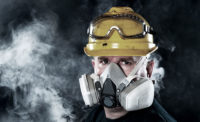Fit testing
Before an employee is allowed to use any respirator with a tight-fitting facepiece (whether used in negative pressure or powered/supplied-air configuration), the employee must be fit tested with the same respirator make, model, style and size that will be used in the workplace. Types of tight fitting facepieces include disposable filtering facepieces, reusable half or full facepieces, or any other type of facepiece that forms a complete seal with the face. Helmets, hoods and other loose-fitting types of headgear do not require fit testing. Respiratory protection that is worn voluntarily also does not require a fit test. As an aside, remember that in order to allow voluntary use, the employer must demonstrate that an inhalation hazard does not exist and that such respirator use will not in itself create a hazard.
Individual fit testing is required prior to initial use of the respirator and whenever a different respirator facepiece (size, style, model or make) is used, and fit testing must be repeated at least annually thereafter. Employees should be allowed to select from several facepiece models and sizes in order find a facepiece that fits securely and comfortably. A wide variety of tight fitting respirators are available in today’s market, each with unique features that affect how the respirator fits an individual’s face. Facepiece size and shape, materials of construction, noseclips and strap configuration are just a few factors that may influence fit, particularly in filtering facepiece respirators. Comfort features such as nose foam, soft facepiece construction, and exhalation valves may lead to increased respirator acceptance and longer wear times because the respirator is more comfortable and easier to wear.
In Appendix A of its Respiratory Protection Standard, OSHA specifies the kinds of fit tests allowed, procedures for conducting them, conditions for additional fit tests, and acceptable uses for fit test results. Acceptable fit test protocols include both qualitative and quantitative methods. A qualitative fit test (QLFT), such as the 3M FT-10 (Saccharin Solution Aerosol Protocol), is a subjective test and relies on the individual’s response to the fit test agent, while a quantitative fit test (QNFT), such as the ambient aerosol condensation nuclei counter (CNC) quantitative fit testing protocol objectively measures the amount of leakage into the respirator. Fit testing is always conducted with the facepiece in the negative pressure mode using the appropriate filters or cartridges regardless of the intended respirator’s mode of operation (negative or positive pressure) when used in the occupational setting. For tight-fitting facepieces used with atmosphere-supplying and powered air-purifying respirators, the facepiece should be temporarily converted into a negative pressure respirator with appropriate filters for the fit test.
Respirator fit is very important. If a respirator does not seal tightly to the face, airborne hazards can penetrate or enter underneath the facepiece seal and into the breathing zone. Remember that OSHA does not permit employees to wear tight-fitting respirators if they have facial hair that either comes between the sealing surface of the facepiece and the face or that interferes with valve function. OSHA defines the presence of facial hair to be “more than one day’s growth.” This implies the worker needs to have been clean shaven in the face seal area within the last 24 hours prior to the fit test. Tight-fitting respirators are also not permitted when any other condition may interfere with the face seal, such as facial scars, wearing of jewelry or the use of clothing or headgear that projects under the facepiece seal. For those individuals with conditions (including facial hair) that interfere with the face seal, a supplied air or powered air-purifying respirator with a loose fitting facepiece, hood or helmet may be a good option.
Consider comfort
Comfort of the facepiece is also important. If the facepiece does not fit comfortably, the user may resist wearing respiratory protection, may become distracted and less attentive on the job, or may need to take additional breaks to find relief from the discomfort. The respirator fit test should always include a comfort assessment, especially when evaluating a facepiece the user has not worn in the past. When performing the comfort assessment, consider the use of other personal protective equipment (PPE) such as safety glasses to ensure these can be worn properly and effectively with the selected facepiece.
Retain records
If an individual does not pass a fit test, he or she may re-don the same facepiece and try again. If the employee is still unable to pass the fit test, then a different facepiece model or size should be selected and fit tested. At the completion of the fit test, document results in the form of a fit test record. Each fit test record should include the employee’s name or identification, type of fit test conducted, specific respirator tested, date of the test, and the fit test result. According to OSHA, employers should retain fit test records until the individual’s next fit test.
Review the regulation
Fit testing is just one of the many elements of a good respiratory protection program as required by OSHA’s Respiratory Protection Standard, 29 CFR 1910.134. Prior to implementing a respiratory protection program, employers should thoroughly review and understand this regulation, which can be found online at www.osha.gov.



